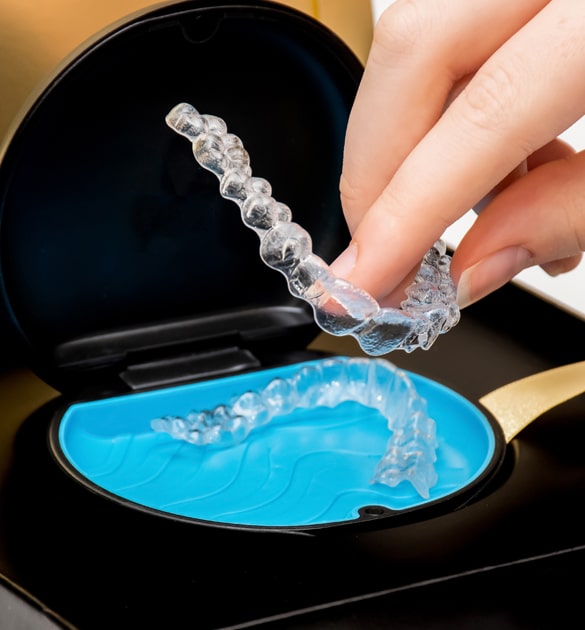
Many people want straighter teeth but hesitate when it comes to traditional braces. The idea of metal wires and brackets can be off-putting. That’s where Invisalign comes in. This treatment offers a clear, removable alternative that’s less noticeable and more comfortable. But how exactly does it work?
Understanding What Invisalign Is
Invisalign is a system of custom-made, clear plastic aligners that gradually shift teeth over time. Unlike braces, there are no wires or brackets. The aligners are made of a flexible thermoplastic material that fits snugly over your teeth. Each set is slightly different, putting gentle pressure in specific areas to move your teeth bit by bit.
The process isn’t magic. It’s backed by science and guided by an orthodontist who customizes the plan to your mouth and goals.
Initial Consultation and Evaluation
The first step begins with a visit to your orthodontist. During this appointment, you’ll talk about your goals, any concerns you have about your bite or smile, and whether Invisalign is a good option for you.
Your orthodontist will examine your teeth, take photographs, and use digital scans or X-rays to assess your mouth’s structure. Not everyone is a candidate for Invisalign, but the technology has advanced enough to treat many bite issues, including gaps, crowding, and mild to moderate overbites or underbites.
Creating a Custom Digital Treatment Plan
Once it’s clear that Invisalign is a fit for your needs, your orthodontist will use 3D imaging to design a precise, personalized treatment plan. This includes a digital model of how your teeth will shift over time and what the final results should look like.
This step is important. It allows both you and your provider to preview the entire process from the first tray to the last. It also gives you a better sense of how long the treatment may take, which typically ranges from six to eighteen months, depending on complexity.
Receiving Your First Set of Aligners
Once your aligners are ready, you’ll return to the office to receive your first set. The orthodontist will check the fit and go over instructions for wearing and caring for your trays. You’ll be expected to wear them for 20 to 22 hours per day, only removing them to eat, drink (except water), brush, or floss.
Each set of aligners is worn for about one to two weeks before moving on to the next. The trays are numbered and designed to follow the digital treatment plan closely.
Daily Life with Invisalign
One of the biggest advantages of Invisalign is that it fits into daily life with minimal disruption. You can take the aligners out when eating, so there are no food restrictions like with metal braces. There’s no worry about damaging wires or brackets.
Cleaning your aligners and maintaining good oral hygiene is essential. You’ll need to rinse and gently brush your aligners daily. Brushing and flossing your teeth after meals is also recommended to prevent bacteria buildup and staining inside the trays.
You’ll feel some pressure or tightness with each new tray. That’s normal—it means the aligners are doing their job. Most people find this discomfort mild and short-lived.
Progress Checkups and Monitoring
Throughout your Invisalign journey, you’ll have check-in appointments with your orthodontist. These are typically scheduled every six to eight weeks. During these visits, your provider will make sure your teeth are moving as expected and may give you several new sets of trays at a time.
Sometimes small adjustments are needed. If a tooth isn’t moving as planned, your orthodontist may recommend wearing a tray longer or adding attachments. These small, tooth-colored bumps are bonded to certain teeth to help the aligners grip better and apply more precise force.
Nearing the Finish Line
As you get closer to the end of your treatment, you’ll be able to see the results taking shape. Your teeth will gradually become straighter, and your bite will improve.
In some cases, once the final tray is complete, your orthodontist may recommend refinements. This involves taking a new scan and ordering a few extra trays to fine-tune the results. Refinements are common and are part of achieving the best possible outcome.
Wearing Retainers to Maintain Results
After completing Invisalign, it’s important to wear a retainer. Teeth can shift back over time if they’re not held in place. Retainers are typically worn full-time for the first few months, then gradually reduced to nighttime use.
Your orthodontist will guide you through this stage and recommend the best type of retainer for your situation. Wearing it as instructed is key to maintaining your new smile.
Why Working with an Orthodontist Matters
While Invisalign is marketed as a simple solution, professional oversight matters. Mail-order aligners may seem convenient, but without in-person exams and monitoring, they carry risks. A licensed orthodontist in Mississippi can ensure your teeth move safely and efficiently. They also have the experience to handle complications and make adjustments along the way.
Choosing a provider who understands the nuances of Invisalign treatment helps reduce your chance of delays, discomfort, or less-than-ideal results.
Conclusion
Invisalign offers a discreet and effective way to straighten teeth without the look or feel of braces. The treatment is personalized, flexible, and often faster than traditional methods. By sticking to the plan and working closely with your orthodontist, you can achieve a healthy, attractive smile that lasts.
Whether you’re considering Invisalign for yourself or a family member, knowing what to expect from start to finish can help you feel more confident about taking the first step. If you’re in Mississippi and thinking about clear aligners, schedule a consultation with an orthodontist to learn if this approach is right for you.